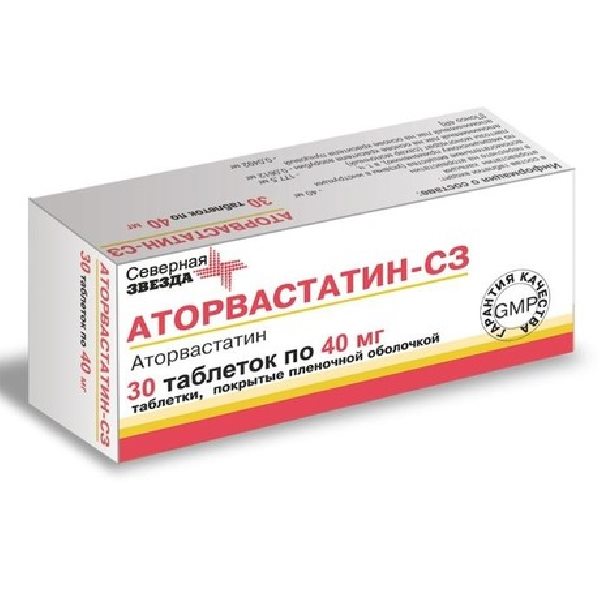You have no items in your shopping cart.

Sku:
Pharmacological action
A hypolipidemic agent from the group of statins. By the principle of competitive antagonism, the statin molecule binds to that part of the coenzyme A receptor where the HMG-CoA reductase is attached. Another part of the statin molecule inhibits the conversion of hydroxymethylglutarate to mevalonate, an intermediate in the synthesis of the cholesterol molecule. Inhibition of the activity of HMG-CoA reductase results in a series of consecutive reactions that result in a decrease in intracellular cholesterol and a compensatory increase in LDL receptor activity and, accordingly, acceleration of LDL cholesterol catabolism (Xc).
The hypolipidemic effect of statins is associated with a decrease in the level of total cholesterol due to Xc-LDL. The decrease in LDL is dose-dependent and has a non-linear, but an exponential nature. The inhibitory effect of atorvastatin on HMG-CoA reductase is approximately 70% determined by the activity of its circulating metabolites.
Statins do not affect the activity of lipoprotein and hepatic lipases, they do not have a significant effect on the synthesis and catabolism of free fatty acids, so their effect on the level of TG is secondary and mediated through their main effects on lowering the level of LDL-C. The moderate decrease in TG levels in statin therapy appears to be due to the expression of the receptor (apo E) receptors on the surface of hepatocytes participating in the catabolism of the disease, which includes approximately 30% TG. Compared to other statins (with the exception of rosuvastatin), atorvastatin causes a more pronounced decrease in TG levels.
In addition to lipid-lowering effects, statins have a positive effect on endothelial dysfunction (preclinical signs of early atherosclerosis), on the vascular wall, atheroma state, improve the rheological properties of blood, and possess antioxidant, antiproliferative properties.
Atorvastatin reduces cholesterol in patients with homozygous familial hypercholesterolemia, which usually does not respond to lipid-lowering therapy.
Indications
Primary hypercholesterolemia (heterozygous familial and non-family hypercholesterolemia (type IIa according to Fredrickson classification), combined (mixed) hyperlipidemia (types IIa and IIb according to Fredrickson classification), disbetalipoproteinemia (type III according to Fredrickson classification) (as a supplement to the diet), family endogenous hypertriglyceridemia (type IV according to Fredrickson classification), resistant to diet, homozygous familial hypercholesterolemia with insufficient effectiveness of diet therapy and other non-pharmacological methods of lech
Primary prophylaxis of cardiovascular complications in patients without clinical signs of IHD, but having several risk factors for its development - age over 55, nicotine dependence, arterial hypertension, diabetes mellitus, low concentrations of HDL-C in the blood plasma, genetic predisposition, h. against the background of dyslipidemia.
Secondary prophylaxis of cardiovascular complications in patients with ischemic heart disease in order to reduce the total death rate, myocardial infarction, stroke, re-hospitalization for angina pectoris and the need for revascularization.